
Radios and Televisions
YES! There was TV in the Swing Era
The following links will direct you to topics discussed on this page:
- Overview and Introduction
- RCA Vintage Projection TVs - TRK-12,Trk-9,TRK-5
- DuMont Televisions
- Early Color Television - RCA 21-CT-55
- Montgomery Ward "Airline" TV and Aftermarket Attachments
- Motorola VT-71B Table Television
- Farnsworth and Television
- The Original SONY Watchman
- General Marshall's Television Set
- Casio Micro-Color Television
- Custom-Built Moderne Console
- Ultra-Rare RCA Console
- Vintage Television Ads
In addition to television stuff, we have a Radio Page, a Calendar of Swing Dancing in DC, a Directory of Vintage Clothing Stores and a Guide to 1940s Collectibles. Thanks for tuning in! Feel free to Contact Me if you have questions or want to share photographs and television stories with the rest of the readers.
It's virtually impossible to have a large collection of vintage televisions simply because they take up so much room. If you want to know about older TV Sets, you really need to get this book:
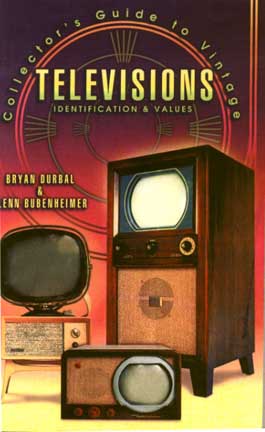
The Collector's Guide to Vintage Televisions
We bought our copy at Zap & Company
315 N. Queen St, Lancaster Pa (717-397-7405), about $15
Television has been around for a lot longer than most of us realize. Beginning in the mid-1930s, both Germany and England had regularly scheduled broadcasts. In Nazi Germany, the only place that you could watch television was at an auditorium at the Post Office -- programming was limited to political, sporting and cultural activities. The fare was not much different in England, but you could at least own your own television -- once you had purchased a license to do so.
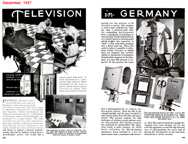


Television in Germany and England
Click to enlarge any photo
German and British television used the Barrie system in which the picture was created by a whirling disk that had holes punched in it. When light passed through the hole, it activated a photosensitive tube that sent millions of little flashes of light down the wire. At the receiving end was another disc that "reassembled" the images. This was a very sensitive process in which the speed of the receiving wheel had to exactly match that of the sending wheel. We have found a "do-it-yourself" article on making these discs that you can download if you are still curious about mechanical TV.
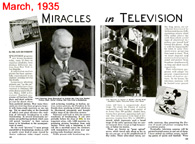
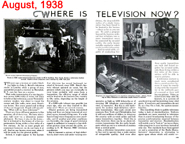

Future of Television
(left) from Popular Mechanics March, 1935
(middle) from Popular Mechanics August, 1938
(right) from Popular Mechanics September, 1939
Click to Enlarge
Television was available in the US, but somewhat later because it used an all-electronic process developed by Philo Farnsworth (see below). Vladimyr Zworkin invented a similar process and the two dueked it out in the courts. Farnsworth won the credit for inventing electronic television, but the financial muscle of RCA ensured that the Zworkin system would be used -- and it was used until analogue TV was abolished in 2009.
- Click here to download "Miracles of Television" March, 1935
- Click here to download "Where is Television Now" August, 1938
- Click here to download "The Future of Television" September, 1939
That's about all we have to say about the history of Television.
We have restored a
PHILCO RADIOBAR
Click here to see the process
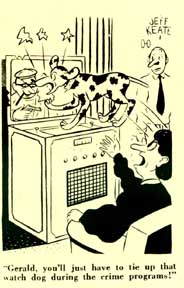
Projection Television
This cartoon is very interesting to me, because it is the only instance that I have found in which an early projection TV is represented.
I am certain that only a few of you have ever heard of a Projection TV, so here is some history:
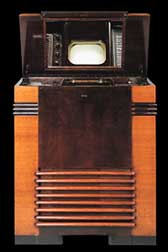

(l.) The TRK-12 (as sold) and (r.) in See-through Lucite
The 12" mirror-in-lid TRK-12 was RCA's first television to be sold to the public. Priced at $600.00, it was RCA's most expensive yet most popular pre-war model. The pictures were viewed indirectly by reflection in a mirror built into the cabinet lid. The length of picture tubes (Kinescopes) available at the time necessitated the mirror-in-lid design. Vertical orientation of the tube minimized the protrusion of television cabinets out from the living room wall, and the mirror lid could be closed, enabling the television and radio to be hidden when not in use. The Lucite "See Through" model was made for the 1939 World's Fair and was very popular among fair-goers.
The TRK-12 had some smaller brothers that did not use the projection mechanism. Here are the TRK-9 and TTT-5
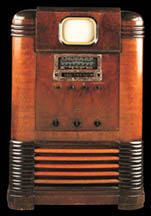

RCA TRK-9 and TT-5 the 1939 World's Fair
Click to enlarge any photo
We have a separate web page that shows additional technical wonders besides television at the 1939 New York Worlds Fair.
There was also a matching electro-acoustic piano shown at the Fair to complement the TRK-9. Here is a picture of the Storytone piano at the 1939 World's Fair (with the TRK-9 in the background) as well as a Storytone in the home of Paul, one of our readers. This is an extremely rare and historically important instrument. The Storytone piano was built in 1939 in a joint venture between Story and Clark and RCA - the piano has normal strings and action but no soundboard - the sound is amplified by pickups and a speaker system making it the world's first practical electric piano. The sound is very beautiful considering its design during the infancy of amplified instruments. The Storytone Piano was made famous by artist Earl Hines
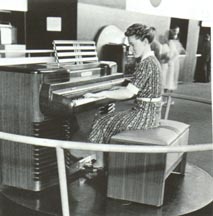
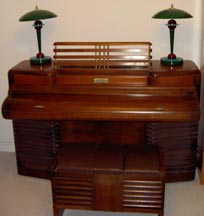
The Storytone Piano at the Fair and in Paul's Living Room
Click to enlarge any photo
Here are some ads for the TRK series:
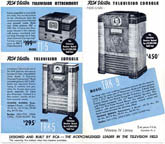

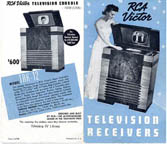
Advertisements and Prices for the RCA TRK Series
TRK = Television Receiver, Kinescope
(middle) TT-5 article from Popular Mechanics August, 1939
Click to enlarge either photo
Here are more ads that feature the TRK-12. On the left is a Philip Morris Cigarette ad that links the product to the novelty and sophistication of television. (We don't know if this is an instance of cigarettes selling television or vice versa.) On the right is an ad taken from a 1939 issue of Esquire magazine, the authoritative men's publication of the era. You'll note that it mentions a "TV add-on" that could be purchased to go with the top-of-the line console model radios (Model TT-5, in the ad above.) A high quality console radio cost about $500 at the time, and a $200 add-on would be significant. It looks like the TRK-12, priced at $600 was fairly competitive in this rarified market (see below.) I have never seen one of these add-on devices like the TT-5 (except in drawings) and would appreciate any more information. Here is how to Contact me.

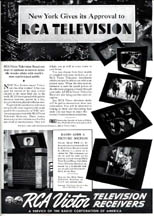
More Advertising for the RCA TRK Series
TT = Television Top ?
Click to enlarge either photo
On the subject of economics, below you'll find an article on Televison from the a 1939 issue of Esquire. The piece was written by "Ranger" who would be the equivalent of the magazine's high technology geek today. It is noted that the price of a TV receiver ranges from $100 to $1000, depending on features. To give you an idea of what $1,000 would have bought in 1939, we also show an advertisement for the new Chrysler automobiles -- the Chrysler Royale was priced at $1,010. Today, a modestly equipped Chrysler M-300 would cost about $30,000, so you can see that TV was reserved for the upper classes only.
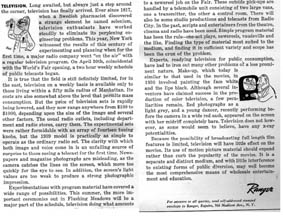
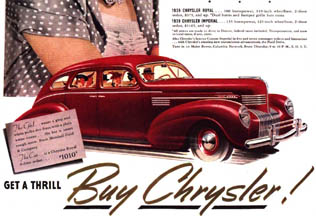
Relative Economics of Television in 1939
Click to enlarge either photo
Here are a few more 1939 ads for competing products. On the left, you'll se an ad for GE televisions showing the thrill that could be brought to a boy's life by TV (at the time, most programming was, in fact, sports events. Since the ad appeared in Fortune, it is most likely targeted at the guilt of executives too busy to spend time with their son. In the center, you'll se a 1939 ad for Buick cars that shows the product being advertised on TV. This is of some interest since the FCC did not allow commercial broadcasts until late in 1940. GM had either astounding foresight or extreme faith in their lobbyists. Finally, on the right is an ad for TVs at Bloomingdales, certainly a high-end merchandiser. Bloomies is selling DuMont sets, which are discussed below. Since they were virtually hand-made, we expect that they were priced somewhat higher than the RCA models.
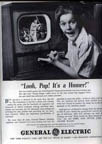
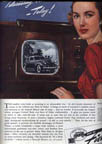

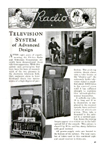
Social Context for Television in 1939
Click to enlarge either photo
By 1948, RCA had worked out a fairly sophisticated optical system to project an enlarged image onto a ground glass screen. This model, the 8PCS41 series was only sold for a short time as the market was moving to larger CRTs rather than projection systems, largely because the projected images tended to be washed out in normal room light.
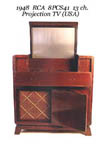
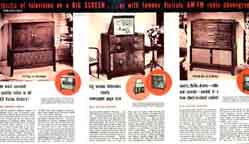

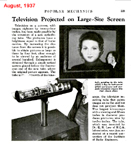
The RCA 8PCS41 Projection TV System
Patent No. 2,438,022
Bottom: Theater projection system
Click to Enlarge
Never Say Never...
One of my readers sent this cartoon, taken from a 1947 book called Addams and Evil. So, now there are two cartoons with a projection TV...
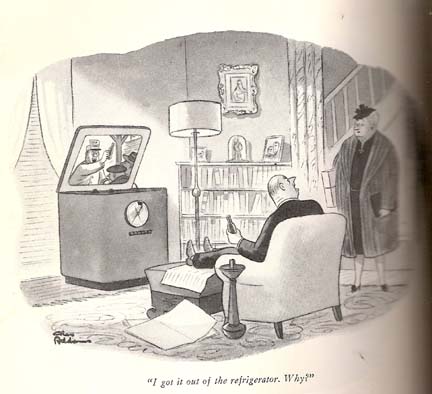
I have shown this to a few people and they don't get the gag at all, so here goes.
- First, the only things that were shown on early TV were sporting events (like baseball games).
- Second, in the old days, you could actually buy a bottle of beer at the ballpark.
- Third, the cameramen in the early days took pictures of the crowd -- it was a big thing to have said thaqt you "had been on TV" and viewers were VERY interested to see their relatives on TV.
- Fourth, the exact nature of TV was unknown to most people, and it was common to believe that almost anything could be transmitted remotely.
SO -- the wife comes home, sees the vendor on TV and the husband with a bottle of beer. She asks incredulously "Where did you get that [bottle of beer]" The husband says that he got it from the refrigerator. The joke is the wife's misperception of Television -- something that could only be funny in 1946...
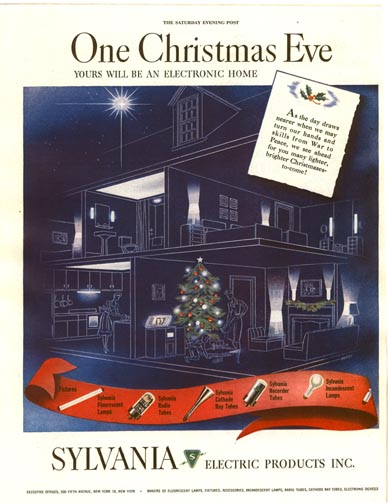
Ad for Sylvania Tubes
"Just wait until after the war when all these amazing things will be around..."
From The Saturday Evening Post December 9, 1944
This ad from Sylvania promises that the Post-WWII future will include a TRK-12 in the Living Room.
Click here to look at another type of collectible, or keep on scrolling for more Televisions.
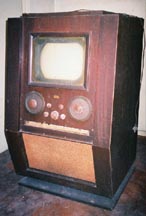
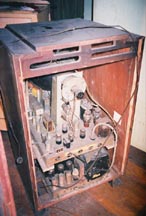
The DuMont "Clifton" Model, front and back

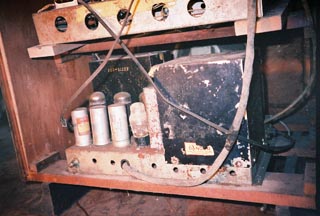
The Picture Circuitry (left) and Receiver Circuitry (right) Click to Enlarge
Posted July 31, 2002
1947 DuMont Teleset
This is the DuMont Clifton RA-102 (serial number 6230) made in 1947, a VERY early Teleset, as these things were known in the 1940s. It is entirely handmade, the case is solid mahogany, and weighs a ton. This is an extremely significant piece.
Why is this so important?
The reason follows, but befor you read on, place in your mind the epic battle between VHS and Betamax, or more lately, the battle between Netscape and Internet Explorer. Every technological revolution produces a struggle for market domination. As you read on, bring to mind your images of Apple vs Microsoft
In the 1930s and 1940s, Allen DuMont was at the forefront of TV technology and programming. DuMont Laboratories perfected the first practical cathode ray tubes (CRTs) and the first all-electronic TV receivers.
In the 1930s DuMont, an electrical engineer and vice president of a New Jersey radio-parts firm, began working in his garage on an inexpensive, long-lasting CRT. In 1939, people were crowding around DuMont television sets to watch President Franklin Roosevelt open the World's Fair.
One of DuMont's early inventions was the "tuning eye", which he sold to RCA for $20,000 (for some background on this device, click here). DuMont developed the first long-lasting cathode ray tube, the basis of electronic television, and was first to offer a home television receiver to the public in 1939. DuMont also applied for an experimental television station in New York City, which went on the air as W2XWV in 1942. Two years later, the station was licensed commercially as WABD, channel 5 (for Allen B. DuMont). DuMont also owned WTTG in Washington, D.C. (originally W3XWT), also on channel 5, which received its commercial TV license in 1945.
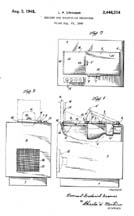
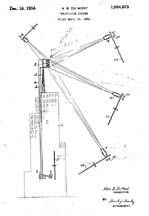
The DuMont Laboratories Representative Patents
Alternative Projection TV Patent No. 2,446,214
DuMont Television System Patent No. 1,984,693
Click to Enlarge
By 1947, DuMont had the beginnings of a television network, with stations in New York, Washington and Pittsburgh. Because of his partnership with Paramount Pictures, the FCC refused to permit DuMont to acquire more stations.
To survive, his network relied on innovative strategies. In 1947, with "The Small Fry Club" DuMont established television's first children's program. "Captain Video and His Video Rangers," an outer-space adventure, also became hugely popular.
It was on the DuMont Network that comedian Jackie Gleason developed the format for ''The Honeymooners,'' the classic 1950s series that was later broadcast by NBC. And here, reporter Mike Wallace first aggressively questioned public figures on the air.
DuMont pondered how to counteract successful competitors like ''Texaco Star Theater,'' starring Milton Berle. Rather than offer another comedy, the DuMont Network aired Bishop Fulton J. Sheen's ''Life Is Worth Living,'' a religious show that developed a loyal following.
In 1952, the Dumont Network aired professional football and basketball, but in time, lost out to other networks that could afford to pay more for the television rights. Eventually, DuMont was forced to sell his stations, but the DuMont Network's legacy in programming remains an important chapter in television history.

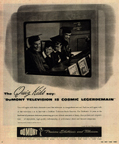


Ads for Dumont TV
QUIZ KIDS was heard every Sunday afternoon on NBC Radio sponsored by Alka-Seltzer
Two of the most famous "kids" are shown:
"Harvey" Bennett, successful TV producer in the ’70s;
the most well known is "The Six Million Dollar Man"
"Joel" Kupperman Professor of Philosophy at the University of Connecticut,
author of the book Six Myths about the Good Life,
Click to Enlarge
Click here to look at another type of collectible, or keep on scrolling for more Televisions.
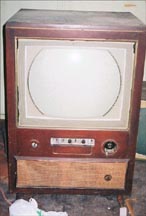

RCA Model 21-CT-55 Click to Enlarge
Posted July 31, 2002
Very early 21 Inch Color TV
The RCA 21-CT-55, a 21 Inch Color Television made in 1955.
Why is this significant??
In the early 1950s, two competing color TV systems emerged. CBS proposed a system which transmitted an image in each of the three primary colors sequentially. A wheel with segments of red, green, and blue rotated in front of the camera, while a similar wheel rotated in front of the television screen, synchronized to the one at the camera. The advantage of the system was that it was inexpensive. Eventually, the wheel at the receiver could be replaced with a tri-color picture tube when the cost of these tubes came down. Unfortunately, the system was not compatible with the black and white standard. This was an astoundingly complex mechanism. You can read about it yourself in an article from the August 1951 issue of Popular Science.
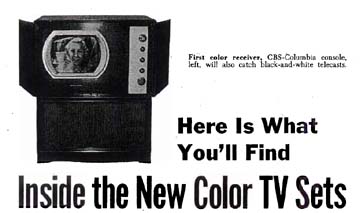
Click the Photo to Read the Article
The other system was proposed by RCA, and was eventually adopted by the FCC. It used no mechanical parts, and was compatible with black and white sets.
For a few months, test broadcasts were done using the CBS system. Some manufacturers, such as Admiral, made sets for the CBS standard.
Later, the FCC adopted the RCA compatible system. The first color television sets for this system were sold in 1954. They used a 15 inch screen. Later that year, 19 inch sets were made, and by 1955 all sets were made with a 21 inch picture tube; The RCA 21-CT-55 is one of these. Several manufacturers made 15 and 19 inch sets, most in very small quantities.
The first set was made by Westinghouse, and sold for $1295. RCA introduced the CT-100 a few weeks later, at a price of $1000.
GE sold its 15 inch set for $1,000, Sylvania's cost $1,150. Emerson rented color sets for $200 for the first month and $75/month thereafter.
By the summer of 1954 there was already a shakeout. A headline in the New York Times said "Set Buying Lags - Public Seen Awaiting Larger Screens, Lower Prices". Motorola and CBS promised a 19 inch screen at $995.
In 1955, Raytheon introduced a 21 inch set for $795 and CBS offered a trade-in of up to $400 for their black and white sets towards the purchase of a $895 21 inch color model. The 21-CT-55 came out in 1955 and cost $898.
RCA Victor started production of the 21-CT-55 on December 1, 1954. RCA released the 21CT55's service literature, "1954 No. T13", on November 24, 1954. RCA also published a Television Service Clinic booklet, "Technical Features of the RCA Victor Model 21CT55 Color Television Receiver". To quote from it:
"The RCA Victor Model 21CT55 color television receiver is a direct-view console which reproduces high-quality television pictures in full color from a standard color television signal, and automatically, with no adjustment or attachments, high-definition black-and-white television pictures from a standard black-and-white television signal.
The picture displayed on the screen of a 21-inch tricolor kinescope, the 21AXP22, has an area of approximately 255 square inches (2 1/2 times the prior year's 15 inch CT-100). The 21AXP22 employs electrostatic focusing and electromagnetic convergence. Ultor voltage is 25,000 volts. In conjunction with the 21-inch tricolor kinescope, the convergence and purity arrangements provide ease of adjustment, and increased accuracy and stability of color registration.
One of the customer convenience features in this receiver is that convergence and focus are no longer customer adjustments from the side of the cabinet but are internal and are preset by the service technician.
Additional features include: a removable top panel to facilitate servicing and adjustment, and the location of most of the functional controls at the receiver front. These control are located under the tilt-down control cover or behind the removable wood panel directly below the control cover. Dual loudspeakers are provided for sound reproduction."
By the end of 1957 only 150,000 color sets had been sold.
Click here to look at another type of collectible, or keep on scrolling for more Televisions.
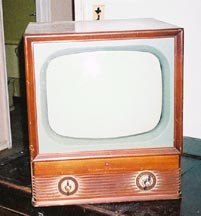
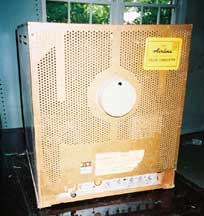
1950s Montgomery Ward "Airline" TV
Front and Back Before Restoration
Click to Enlarge
Posted July 3, 2002
Airline Television
We just discovered this marvelous artifact from the early 1950s. It seems that our friend Carl Kirtley bought a house that had been condemned. It had been uninhabited for many years and the owners were sort of "Packrats". This is an understatement. When we peered into the house, we felt like Howard Carter and King Tut's Tomb. These people never threw a thing away from 1940 through 1990. There are three complete kitchens -- the cabinets and appliances were not discarded, but simply moved to the basement. No doubt, you will see many things from Carl's Treasure House. The first items to be "rescued" are electronics, which had to be relocated to my workbench for testing.
This is a television from about 1951. It is the Airline brand, which was distributed by the Montgomery Ward Company. This is going to be the first full scale TV that I have worked on, so it is going to take a while. The internet is relatively dim with respect to Vintage Television, so you will learn along with me.
At the moment, I can tell you that the cabinet is actually solid mahogany! No veneer -- real mahogany!
The Airline TV sat in a corner of the workshop from 2002 to the Spring of 2006, waiting in vain for a new picture tube to materialize on e-bay or at the shows. No such luck. So, regretfully, I did the next best thing. I carefully preserved the innards (minus the broken picture tube...) and refinished the case. Then I put a brand new Panasonic television inside the case. The remote even works through the speaker grille. I even refinished a little table to match the TV. The newly "restored" set went into the bedroom until I found a pair of drive-in movie speakers at a yard sale.
After looking at the speakers for a while, I thought that it would be interesting to display them in the bedroom. (Those of you who actually went to Drive-Ins in your youth will understand this). The, an ad stuffed in the Sunday Paper heralded the fact that Circuit City was selling a Zenith DVDPlayer/Home Theater system for about $90. I went to the store and they had an open box Zenith that they sold me for $50 because it was missing one speaker. I planned to use the Drive-In speakers as the rear Left and Right. It was fairly easy to rewire the innards of the Drive-Ins and to put brand new speakers inside. (Any good 4" speaker will fit just fine.) When I took the Zenith speakers apart, I found that they were junk, although the subwoofer was serviceable. I had LOTS of better speakers around the house --- inside some of the radios that I planned to restore. So, the five speakers in the Home Theater System are actually inside old radios that are cleverly distributed around the room.
Here's what the final setup looks like:
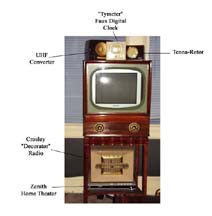
The Airline TV in Its 21st Century Configuration
Click to Enlarge
You will note that some additional equipment has been added to the basic TV -- much in keeping with the evolution that took place during much of the 1950s. The Television Set had been TOO EXPENSIVE to throw away (early ones cost the equivalent of two months wages for the average working man). Thus, as technology changed, it was necessary to add some "peripherals."
In the late 1950s, the thirteen VHF channels were not enough to supply the demand for television programming. Thus, short wave users were booted off the air and 99 Ultra High Frequency (UHF) channels were created. The FCC mandated that all new television sets be wired to tune in UHF signals, but those with sets made before this ruling had to buy a UHF Converter as shown below. This was simply connected between the VHF antenna and the RF input on the main TV, as supplemented by a small loop UHF antenna.
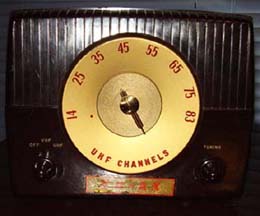
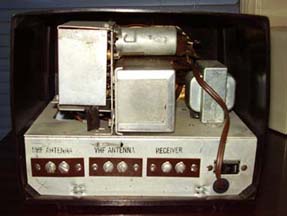
The UHF Converter
Click to Enlarge
Signal strength depended on the antenna being aligned with the RF source. In metropolitan areas with strong signals, this did not really matter and people got by quite well with the "rabbit ear" antenna that came with the set. However, in suburban and rural areas where signal was weak, it was very important to have a properly aligned antenna. Thus, the external folded dipole (looks like a part of a trombone) antenna was erected on the roof. In some areas, even this did not suffice and folks webt outside to rotate the antenna to catch a distant signal. For the more affluent, you could buy a Tenna Rotor sold by the Alliance Corporation in numberless commercials during the late night movies. This was a little box, shown below, that allowed you to orient the antenn from the comfort of your living room. Some models had an automatic tuning circuit (below, third diagram) that would "seek" the best signal. To illustrate this more, I have also reproduced the Canadian Patent Drawings for the Tenna-Rotor.
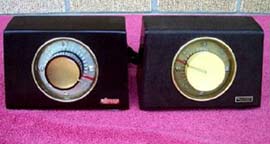
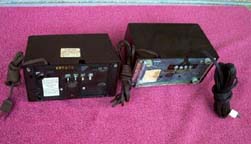
The Tenna Rotor Control Unit
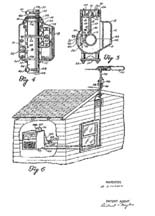
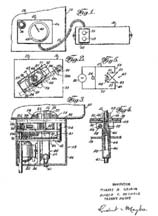

The Tenna Rotor Patent Diagrams
Canadian Patents 497534 and 636446
Click to Enlarge
The final "modern accessory" wasn't so modern at all -- it was a "Tymeter" faux digital clock. This was invented in 1935 by Mr. Frederick A. Greenawalt, for which he received US Patent 1,990,645. It was marketed under various guises by the Pennwood Numechron Company of Pittsburgh, Pennsylvania. However, this nifty little model with a face that looks like a Television set really took off, and soon it was de rigeur to have a Tymeter to keep up with the Joneses. This model has a light AND it glows in the dark! A sticker on the back indicates that it was made in October 1957 at the height of the fad.
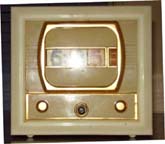
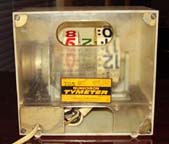

The Numechron Tymeter
US Patent No. 1,990,645
Click to Enlarge
So, the old Ward's Airline is souped up and ready to go for another 50 years. After spending all this money and time, I can now watch DVDs of old kinescopes of The Honeymooners.
Click here to look at another type of collectible, or keep on scrolling for more Televisions.
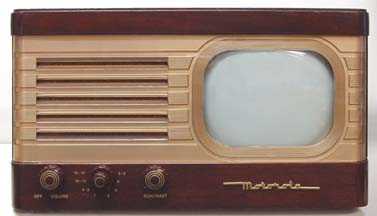
Motorola VT-71B Table Television
..about 1948
Click to Enlarge
Posted February 12, 2009
Circa 1948, this was Motorola's most popular late 1940s TV. This was an inexpensive TV for it's time made for the budget minded. The VT-71 is not one of the best circuit designs of the time but does well with a good signal. Most TV's of this era had 20 or more tubes (some as many as 30), while this one only had 15. Features 8 channels, several must be pre-set for for local stations. Channel positions: 2 or 3, 4, 5, 6, 7, 8 or 9, 10 or 11 & 12 or 13.
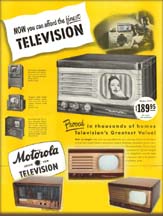
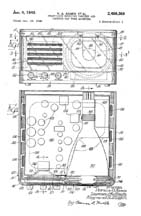
Advertising and Patent for the VT-71B
..V. A. Kamin Patent No.2,458,368
Click to Enlarge
Click here to look at another type of collectible, or keep on scrolling for more Televisions.



Farnsworth Console Radio-Phono
Model EK-263
Click to Enlarge
Posted November 28, 2001
This is a radio and phonograph. BUT, it is HIGHLY significant for Television. Read on to see why.
This gorgeous Farnsworth Model EK-263 Style-Moderne radio-phonograph console was left for junk at Dixon's Auction (nobody bid on it!) I grabbed it up and brought it home. In all fairness, it was a real wreck. I really wish that I had made "Before" and "After" photos. The turntable and radio actually work, although they have been augmented by a modern amplifier, a tape drive, an FM tuner, and a 100CD changer. This required BOTH extensive carpentry and a whole lot of electrical fidgeting.
Now, this was made by the Farnsworth Company somewhere around 1947. Why is that significant to Television? Check out this article from the November 1940 issue of Popular Mechanics.
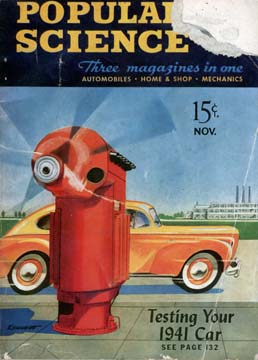

Tribute to Philo Farnsworth!
From the November 1940 Issue of Popular Science
Read the Full Article from Popular Science
Click here to learn even more about visionary inventor and businessman Philo Farnsworth, the man who ACTUALLY invented Television as we know it today. Believe me, this is worth the diversion... Here are some of Philo Farnsworth's Patents:
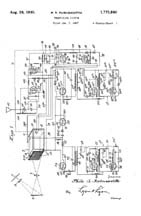
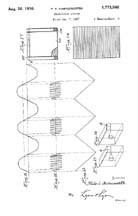
Farnsworth Televison Patent No. 1,773,980
Click to Enlarge
The Tube Lineup is:
- 6SK7 (RF Amp)
- 6SA7 (Conv)
- 6SK7 (IF Amp)
- 6X50T (Rect)
- 6SQ7 (Det Avc, 1st Audio)
- 6V6GT (Output)
Click here to look at another type of collectible, or keep on scrolling for more Televisions.
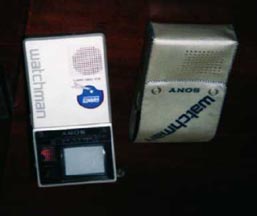
The Original Watchman
it logged many miles with me...
Click to Enlarge
Posted January 10, 2002
This isn't from the Swing Era, but it is one of the very first generation of SONY Watchman portable micro-televisions. I bought this when they were first announced and I was thoroughly annoyed that the only model they had came with a "New York Giants" emblem (I had wanted one for the Steelers...) They were initially sold to sports fans who carried them to football games to catch the instant replay. I also have the aftermarket lens magnifier that made the small picture somewhat more viewable.
Click here to look at another type of collectible, or keep on scrolling for more Televisions.
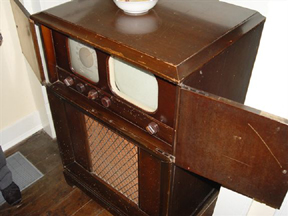
General Marshall's TV Set
A 10 inch TV, not much bigger than the Watchman...
Click to Enlarge
Posted April 6, 2009
George Catlett Marshall (December 31, 1880 – October 16, 1959) was an American military leader, Chief of Staff of the Army, Secretary of State, and the third Secretary of Defense. Once noted as the "organizer of victory" by Winston Churchill for his leadership of the Allied victory in World War II,[1] Marshall served as the U.S. Army Chief of Staff during the war and as the chief military adviser to President Franklin D. Roosevelt. He served as Presidnt Truman's special emissary to mediate the conflict between the Communist and Nationalist forces in China. As Secretary of State his name was given to the Marshall Plan, for which he was awarded the Nobel Peace Prize in 1953. General Marshall is on most historians' short list of the Greatest Americans Ever.
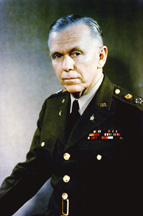


General Marshall and Dodona Manor
General of the Army, Seretary of State and Defense, Nobel Laureate, radio collector...
Click to Enlarge
From 1941 - 1959, General Marshall and his wife lived at Dodona Manor on Leesburg, Virginia. The house was constructed in the mid-1820s for John Dirsh. The house soon passed into the possession of the Ball family, who added an addition. There is evidence that the building served as a female boarding school in the 1850s. The Marshalls bought the house in 1941 and lived there until 1959. It was declared a National Historic Landmark in 1996 and is open for tours. General Marshall had a 1947 10 inch TV from General Electric.
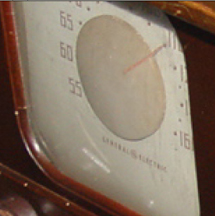
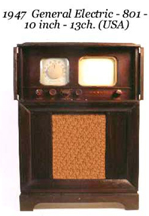
The 1947 General Electric TV
I wonder if the two generals saluted each other...
Click to Enlarge
The Television is a 1947 General Electric Model 801, somewhat remarkable since television did not come to DC until 1948, and reception in Leesburg would have been very spotty. This particular style was made up until 1950, but models after 1947 have 7 knobs instead of five. The set at Dodona clearly has five knobs (the other 2 knobs are for horizontal and vertical control) in the '47 model this was set by a technician.
General Marshall also had several radios that are discussed on our Vintage Radio Page. The kitchen at Dodona Manor is full of marvelous artifacts from the 1940s and 1950s that are discussed on our Retro Kitchen Page.
Click here to look at another type of collectible, or keep on scrolling for more Televisions.
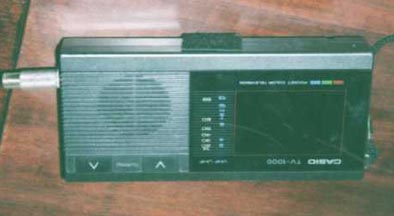
Casio Micro Color TV
Click to Enlarge
Posted January 10, 2002
I used to travel about 75,000 miles a year when I was in the Oil industry. All of my miniature "Conveniences of Home" were of great value to me. This little TV provided a lot of entertainment along the way. This has a little input jack and can be adapted to a VCR or a cable system. It has a very good LCD picture and performs very well.
Click here to look at another type of collectible, or keep on scrolling for more Televisions.
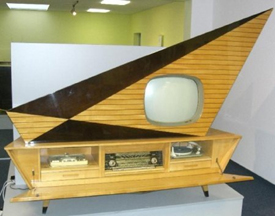 Enbsp;
Enbsp;
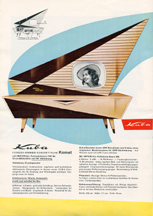
Kuba "Komet" Moderne Console
Click to Enlarge
One of our readers sent us this photo of what he thought was a home-made "Gee-Whiz" entertainment center from what looks like the mid- 1950s. In fact, it is a West German integrated TV/Radio/Phono known as the "Komet", made by Kuba, a German electronics firm. They were sold from 1957-1962 Reader Jon says this: "I missed out on this beauty literally by minutes about ten years ago. It sold for $2.000 here in St. Louis it was purchased by the museum here. "


Ultra-Rare RCA Console
Click to Enlarge
One of our readers sent us this photo of an RCA television that is supposedly quite rare. He writes:.
"... Wasn't sure but thought you might like a picture of a television that should be the only one left. It was purchased in 1948 by my parents and they were told by the dealer they bought it from that they had a recall because of a weak leg. My parents decided to keep the television. The dealer told them there were about 365 made and all but 5 had gone back on a recall. This seems to be one of them. There are missing knobs and the back is missing. It has a bad resistor that we could not find years ago but other than that it is a neat looking set. It is solid mahogany and now has that weak leg so I have stored it for years off the legs to preserve it... As I remember my parents referred to it as the Queen Anne model if that would help. I have been trying to figure out what to do with the set for years and recently found a mueseum in Ohio and one in Canada but just have no idea whether they are in it for themselves or not. Hopefully I will find a long term home for it one day..."
His parents were right -- the cabriolet legs (they look like they have knees) certainly mark it as the Queen Anne style.
Vintage TV Ads

Subway Advertising Card for the RCA TV, c. 1950
This was on our Nostalgia Subway Ride, Christmas 2008
Click to Enlarge
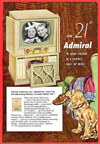


Kids and Dogs
Click to Enlarge

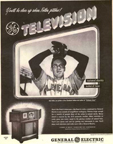
Sports Were a Big Component of Early TV
(left) Ad from LIFE Magazine October 6, 1941 (just before Pearl Harbor)
Most Folks Would Have to Wait 8-10 Years to Experience This (Right)Ad From LIFE Magazine, September 18, 1941
Bob Feller pitched 3 "No-Hitters" during his career with Cleveland
Click to Enlarge



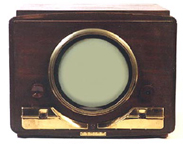
The Zenith "Porthole" TV
Model G-2355 (12" console), Model 28T925R (10" table model)
Click to Enlarge




Networks and Networking
(left) Early 2-Station Networks (1944 - 1945)
Westinghouse owned stations and made TV sets -- and sponsored the 1952 Conventions
ABC promoted its schedules in 1950 to convince listeners that it was really a major network
Click to Enlarge
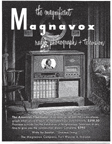
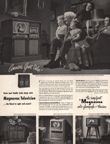


Home Entertainment Centers
Click to Enlarge
Click here to look at another type of collectible.
Counter for the Entire Site (not just this page..)
Home | About Lindy | 1940s Collectibles | Upcoming Events | Vintage Clothes
The Guide - Establishments - Travel - Accessories
Music | Links | Photo Gallery | Extras | Contact